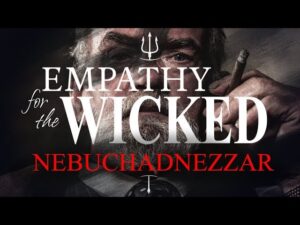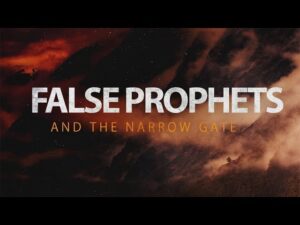EXODUS: YHVH the Dragon Slayer • Echoes of Exodus
Message recorded live on

EXODUS: YHVH the Dragon Slayer • Echoes of Exodus | Exodus in Genesis | Messianic Passover Service

This Bible teaching from Founded in Truth Fellowship, likely delivered by Matthew Vander Els, explores the recurring theme of the dragon slayer throughout the entirety of the Bible. It posits that the biblical narrative can be understood as a story of a warrior who slays a dragon to rescue his bride. This perspective encourages a deeper understanding of the Bible not just as a historical or doctrinal text, but as a rich literary work inspired by the Holy Spirit through numerous authors over millennia. The teaching emphasizes that like a good movie that reveals new details upon repeated viewing, the Bible contains layers of sub-stories, themes, and motifs that enhance its beauty and meaning.
The Dragon Slayer Motif: An Overarching Theme
The concept of a divine warrior battling a chaotic, dragon-like sea monster is not unique to the Bible; it is found in the myths of many ancient Near Eastern cultures, including Sumerian, Mesopotamian, Babylonian, and Canaanite traditions. These cultures spoke of primordial waters of death inhabited by serpentine sea monsters like Lotan (in Canaanite myth, a seven-headed dragon) and Tiamat (in Mesopotamian myth). In these myths, the creation of the world often involved a deity defeating these chaotic sea monsters. Even later Greek myths (Zeus vs. Hydra) and Germanic legends (Thor vs. Jormungandr) echo this pattern, as does the Christian legend of St. George.
The biblical authors were aware of these prevalent myths and deliberately appropriated their imagery, not to endorse the pagan deities, but as a polemic against them and to exalt Yahweh as the one true God. They used the dragon slayer motif as a “breadcrumb” throughout the biblical narrative to illustrate God’s power over chaos and evil.
Water as a Symbol of Chaos and Death
In the ancient world, particularly in the ancient Near East, water held a dual symbolic meaning. While essential for life, large bodies of water like the sea were also associated with chaos and death. The vast, uncontrollable ocean was seen as a dangerous realm, a potential portal to the underworld. This is reflected in Jonah’s description of being in the belly of the fish as being in the “realm of the dead” with waves overwhelming him.
This symbolism is evident in the creation account in Genesis 1, which describes the earth initially as “wild and waste” with “darkness over the watery deep.” God’s act of separating the waters is portrayed as an act of bringing order out of chaos, a new creation.
Exodus: A New Creation and the Defeat of the Dragon
The book of Exodus is presented as a new creation narrative for God’s people, mirroring the themes of Genesis. The entire Exodus narrative is framed by water: the waters where male Hebrew babies were to be thrown at the beginning, symbolizing death, and the waters of the Red Sea at the end, representing both death for the Egyptians and salvation for the Israelites. God’s parting of the Red Sea to bring forth dry land echoes the creation story. Furthermore, the first two plagues of Egypt involved water turning to blood and an infestation of frogs, the latter being a symbol of the underworld, depicting Egypt itself as Sheol, the realm of the dead, for the enslaved Israelites.
Psalm 74 directly confronts the ancient myths by stating, “You divided the sea by your strength; you broke the heads of the sea monsters in the waters. You broke the heads of Leviathan in pieces.” Here, the psalmist asserts that it was Yahweh, not the pagan gods, who conquered the chaotic sea and its monstrous inhabitants. The terms “sea monster” (Hebrew: tanin) and Leviathan are used synonymously, both representing primordial dragon imagery shared across ancient Near Eastern cultures. The Amplified Bible even interprets Leviathan in this context as representing Egypt.
Moses and the Serpent/Dragon
A seemingly small detail in Exodus 4 and 7 reveals a deeper layer of this dragon slayer theme. When God tells Moses to throw his staff on the ground, it becomes a nakash, the Hebrew word for snake or serpent. However, when Moses and Aaron confront Pharaoh and Aaron throws down his staff, the Hebrew word used is tanin, which translates to dragon, sea serpent, or monster in various translations like the Literal Standard Version, Aramaic Bible in Plain English, and Young’s Literal Translation.
This deliberate shift in terminology suggests that the biblical authors intended the reader to see not just snakes, but powerful, primordial dragons battling in Pharaoh’s court. Aaron’s staff, representing God’s power, swallows the staffs of the Egyptian magicians. The Hebrew word for “swallow” (bala) is the same word used in Exodus 15:12 in the song of Miriam, describing Pharaoh being swallowed by the earth beneath the waves of the Red Sea. This inferred dragon fight foreshadows God’s ultimate victory over Pharaoh, the “dragon” of Egypt.
The Serpent in the Garden and the Ultimate Dragon in Revelation
The dragon motif extends beyond the Exodus. Enemies of Israel, such as the leaders in Canaan and Moab, are poetically described as having their heads crushed, echoing Yahweh’s victory over Leviathan. Figures like the evil Ammonite king Nahash, the giant Goliath (whose name root means skull and who is described with scales like a dragon), and the king of Babylon are also associated with serpent or dragon imagery.
The Bible’s narrative is bookended by the dragon. The serpent in the Garden of Eden in Genesis is revealed in Revelation 12 to be the “enormous red dragon with seven heads and ten horns,” identified as Satan. Revelation 12 portrays a cosmic battle where Michael and his angels defeat the dragon and its forces, signifying the ultimate defeat of this ancient enemy. This victory is tied to the birth and ascension of the “male child” who will rule all nations, a clear reference to Jesus.
Application for Everyday Life
Understanding the dragon slayer motif provides valuable insights for Christian living:
- Recognize the ongoing battle: The struggle against evil and temptation is a real, ongoing battle against the forces represented by the dragon.
- Trust in the ultimate victory: Just as Yahweh defeated the dragon in the Exodus and Jesus defeated the ultimate dragon, believers can have confidence in God’s power to overcome any challenge.
- Leave behind the “Egypts” in your life: Egypt symbolizes slavery to sin and the world. Believers are called to leave behind bitterness, unforgiveness, and harmful lifestyles, walking through the “waters” of difficulty on “dry land” because of Christ’s victory.
- Embrace your freedom in Christ: As those under the sovereignty of Jesus, the dragon has no ultimate power over believers. They are called to live in this freedom.
- Maintain humility: Remembering our past “slavery” to sin should foster humility and a recognition that our deliverance comes from God’s grace.
- Participate in God’s story: Believers are called to be part of God’s ongoing story of redemption, mediating heaven and earth as a “kingdom of priests.”
In conclusion, the Bible’s consistent use of the dragon slayer motif, from the chaotic waters of creation to the ultimate defeat of Satan in Revelation, reveals a powerful narrative of God’s victory over evil. The Exodus story serves as a key illustration of this theme, foreshadowing the ultimate triumph of Jesus, the Messianic Passover Lamb, who delivers his people from the bondage of sin and death.
For more Bible Teachings, click here.
About Founded in Truth Fellowship
Founded in Truth Fellowship is a Messianic Fellowship in Rock Hill, SC that provides Biblical teachings, fellowship, and resources for Biblical studies. Founded in Truth Fellowship is able to spread the gospel and the word of Yeshua because of supporters like you. If Founded in Truth has been a blessing to you or your family, we ask that you would give so that the same messages can bless others.
To give to Founded in Truth Fellowship, click this link: Give to Founded in Truth Fellowship
Founded in Truth Fellowship, 1689 Springsteen Rd, Rock Hill, SC 29730 | (803) 627-8623
Visit our website: https://foundedintruth.com


